The Disciples of Christ
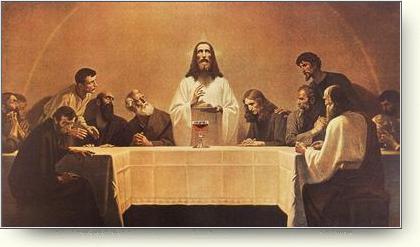
The introduction to this page is at Death - Forward Please go there first.
This is what the Nazareans - The Ebionites taught; They insist that Jesus was a man, not God, and was not born of a virgin. They claim that he became the Messiah only at the time of his babtisim - that is, his anointment or coronation. They use only the Gospel of Matthew ( their version ) and like Jesus himself, as well as the Essenes or Zakokites of two centuries before, expound upon the prophetic books of the Old Testament. They adhere scrupulousy to Judiac law (Moses). They reject the Pauline letters, and they reject the apostle Paul, calling him an apostle 'from' the law.
Undoubtdly you have seen many references to Jesus being a "Nazerene". This line of kings was not extinguished in the centuries that followed the killing of the disciples. In 318 a Bishop of Rome is reported to have had a meeting with Nazarean or Desposyni leaders directly descended from Jesus's family. At the same time, the church historian Eusebius was attacking the Nazareans ( whom he, like Irenaeus, calls Ebionites ) for being heretical. They held that the epistles of the apostle Paul ought to be rejected altogether, calling him a renegade from the law; and using only the "gospel of the Hebrews", they treated the rest with scant respect'.
They are 'not ashamed', Epiphanius writes indignately,
to denounce Paul, believing him to be pseudapostolorum a
'false apostle'.
The Messianic Legacy, Baigent, Leigh, Linclon
This definition of "Nazarene" is very important to the Grail story because it has been so often misrepresented to suggest that Jesus came from the town of Nazareth. For the past 400 years, English language Gospels have perpetuated the error by wrongly translating "Jesus the Nazarene" as "Jesus of Nazareth". There was no connection between Nazareth and the Nazarenes. In fact, the settlement at Nazareth was established in the AD 60s, thirty years or so after the presumed Crucifixion. Nobody in Jesus' early life came from Nazareth - it was not there!
The Nazarenes were a liberal, Jewish sect opposed to the strict Hebrew regime of the Pharisees and Sadducees. The Nazarene culture and language were heavily influenced by the philosophers of ancient Greece, and their community supported the concept of equal opportunity for men and women. Documents of the time referred not to Nazareth but to the Nazarene society. Priestesses existed in equal opportunity with priests, but this was so different from what the male-dominated Hebrew society wanted and what the later, male-dominated Roman Church required.
It has to be remembered that Jesus was not a Christian: he was a Nazarene-a radical, westernised Jew. The Christian movement was founded by others in the wake of his own mission. The word "Christian" was first recorded and used in AD 44 in Antioch, Syria, and NOT as some believe in the time of Christ.
In the Arab world, the word used today, as then, to describe Jesus and his followers is 'Nazara'. This is confirmed in the Muslim Koran: Jesus is Nazara; his followers are Nazara. The word means "Keepers" or "Guardians". The full definition is Nazrie ha-Brit, "Keepers of the Covenant". In fact, the Brit aspect of that is the very root of the country name of Britain. Brit-ain means "Covenant-land".
In the time of Jesus the Nazarenes lived in Galilee, and in that mystical place which the Bible calls "the Wilderness". The Wilderness was actually a very defined place. It was essentially the land around the main settlement at Qumran which spread out to Mird and other places. It was where the Dead Sea Scrolls were produced-discovered at Qumran in 1948. Along with the scrolls, a copy of the Books of Enoch were also discovered. That means this sect followed the Enochian laws of 'astral' teachings. This included astrology, numberology, and healing.
The women in Jesus' life
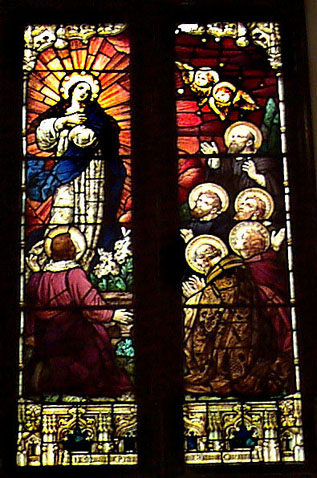 Now look at this stained glass window. How did the
disciples get in a picture of Jesus as a child? It is
called the Assumptiom window, 'assumption' meaning they
think it is Mary, mother of Jesus..Wrong. It is Mary
Magdalene and her child by Jesus.
Now look at this stained glass window. How did the
disciples get in a picture of Jesus as a child? It is
called the Assumptiom window, 'assumption' meaning they
think it is Mary, mother of Jesus..Wrong. It is Mary
Magdalene and her child by Jesus.
The bible concludes that there are 3 Mary's at the foot
of the cross at the crucifixtion. It also concludes that Jesus
had 'brothers' but fails to recognize that they are 'stepbrothers', sons of
Mary and a man named Cleopas.
But see
Jesus' Family Tree
This page does confirm that this first Mary is indeed James'
mother but they call her the 'sister' of Mary. They admit that
she is Cleophas' wife but they still denigh that she is Jesus'
mother.
The conclusion to the 'brothers' and step-brothers
relationship is this; There are not 3 Mary's, there are only two.
Cleophas is Joseph's brother. James, Jude, Simon, Jose
(Joseph) and possibly Matthew are all children of Mary and Cleophas.
The names of the two girls are Salome and Anna.
Jesus and Thomas are Joseph and Mary's children. see Luke 2.7 and
Matthew 1:25, which also describes Jesus as Mary's first born son
and clearly indicates "Joseph had union with her". Is there yet
another child resulting from this union? Matthew 13:55 -56 and
Mark 6:3 indicate that Jesus had brothers and sisters.
Also note that this verse clearly states that Mary was NOT 'a virgin forever' and not a virgin at all as the church proclaims. If this is in the gospel, why does the church dispute it?
Some information says there were 7 women in the group that always followed Jesus. We contend that Mary his mother, Mary his wife, Martha her sister, Mary Magdalene's friend Helena-Salome, who was Jesus' sister and Anna, his other sister were part of this group. Helena was also a high ranking priestess and allowed to wear the red robe of the heirodulai( Greek; sacred woman ). The mother of Zebeddee's sons is with them in Matthew 27:56.
Confirmation from the catholic encyclopedia; The identification of James , the brother of the Lord and James, the son of Mary, and probably of Cleophas or Clopas offers some difficulty. This identification requires the identity of Mary, the mother of James (Matthew 27:56; Mark 15:40), with Mary the wife of Cleophas (John 19:25), and, consequently, the identity of Alpheus and Clopas . Cover-up; As Clopas and Alpheus are probably not two different transcriptions of the same Aramaic name Halpai (CLEOPHAS), it must be admitted that two different names have been borne by one man. Indeed, there are several examples of the use of two names (a Hebrew and a Greek or Latin name) to designate the same person (Simon-Petrus; Saulus-Paulus), so that the identity of Alpheus and Cleophas is by no means improbable.
Joseph died and Jesus' mother Mary married Cleophas as he was
then responsible for Mary by Jewish law. They ( Jude, Simeon,
Jose and James ) are step-brothers of Jesus and the two
sisters all born of Mary and their father Cleophas Matthias.
Thomas is Jesus' twin brother and their father is Joseph.
Christian theological writers have deleted Jesus' relationship
with his brother Thomas and their biological father so that Jesus
can be called 'divine' and 'god' and therefore not human.
However they now admit that Jesus had brothers by blood, which
again contradicts their long standing portrayl of Mary being a
virgin forever. Another painting called 'The Coronation of
the Blessed Virgin' is Mary Magdalene. 'Virgin' is explained below.
The painting is shown on
Death 2
"Mary Magdalene is really someone who has made the church very uncomfortable. That is why you have two Mary's in the Bible: one that is very sexual, and one that is virtuous and spiritual, cut off from her sexuality." Expounding on this; the church declared Mary, Jesus's mother a virgin forever. Then they try and convence us that the other Mary is a prostitute.An example of other corrupted texts is the concept of the Virgin Birth. Our English-language Gospels tell us that Jesus' mother Mary was a virgin; they keep telling us that she was a virgin. Well, let's consider the word "virgin". We understand the word; it tells us that this was a woman with no experience of sexual union. But this was translated not from the Greek initially but from the Latin. That was easy because the Latin called her virgo; Mary was a virgo. It didn't mean the same thing at all! Virgo in Latin meant nothing more than "a young woman". To have meant the same thing as "virgin" does to us today, the Latin would have been virgo intacta, that is to say, "a young woman intact".
Let's look back beyond the Latin text; let's see why they called her virgo, a young woman. Maybe they actually got something right which we've got wrong later on. We discover that the word translated to mean virgo, a young woman, was the old Hebrew word almah which meant "a young woman". It had no sexual connotation whatever. Had Mary actually been physically virgo intacta, the Hebrew word used would have been bethula, not almah.
"Again, on comparing John 19:25 with Matt 27:56, and Mark 15:40 (cf. Mark 15:47; 16:1), we find that Mary of Cleophas, or more correctly Clopas or (Klopas), who they say is the sister of Mary the Mother of Jesus, is the same as Mary the mother of James the Less and of Joseph, or Joses, Jude, Simeon and Thomas." Why would there be two Mary's in the same family? "As married women are not distinguished by the addition of their husband's name, Mary of Clopas must be the wife of 'Cleophas' Matthias. But the reason is so Mary, Jesus' mother can remain a virgin forever, never admitting that she was married twice or had 'other' children. Moreover, the names of her sons and the order in which they are given, no doubt the order of seniority, warrant us in identifying these sons with James and Joseph, or Joses, Jude and Simon, the "brethren" of the Lord."
The existence among the early followers of Christ of two sets
of brothers having the same names in the order of age, is not
likely, and cannot be assumed without proof. Once this identity
is conceded, the conclusion cannot well be avoided that Clopas
and Alpheus are one person, even if the two names are quite
distinct. It is, however, highly probable, and commonly admitted
, that Clopas and Alpheus are merely different transcriptions of
the same Aramaic word Halphai."
from..
The Brethren of the Lord
(Catholic Encyclopedia)
And we found Lazerus's sister Mary Madgalene also was 'raised' in scripture! The origional books of Matthew relate how the rest of the disciples wanted to hurry to be with him and do the same.. more about Mary Madgalene on Jesus'secret life.
Take a close look at the picture at the top of the page. A long haired person is sitting to the right, his left, of Jesus. This is Mary Magdalene. The Renaissance painters knew more than they were telling, but they depicted their knowledge in art.
More proof the disciples were Gnostic..
This man called an apocryphal writer, is said to have been one of
the seventy-two Disciples of Christ, and first Bishop of Babylon,
consecrated by St's. Simon and Jude.
Very little is known about him, and the main reason for mentioning him is a
work in ten books called Historia Certaminis Apostolici
which is imputed to
him. It tells of the labours and deaths of the Apostles.
This compilation purports to have been translated from Hebrew into
Greek by Eutropius, a disciple of Abdias, and, in the third century,
from Greek into Latin by (Julius) Africanus, the friend of
Origen.
But it is really a Latin work, for in it are cited, with the Vulgate
of St. Jerome, the Ecclesiastical History
of Rufinus and his Latin translation of the "Recognitiones" of Clement.
The interest of the work is due to what the author claims to have drawn from the
ancient Acta of the Apostles, and to many ancient legends which have thus
been brought down to us. The text of the pseudo-Abdias may be found in
Fabricius, Codex Apocryphus Novi Testimenti (Hamburg, 1700), 402-742, though
there are parallel texts of single books printed in the Acta Sanctorum.
According to R.A. Lipsius, the work was compiled during the latter half
of the sixth century, in some Frankish monastery, for the purpose of
satisfying the natural curiosity of Western Christians.
At the same time he used much older pseudo-Apostolic materials that he abridged or excerpted to
suit his purpose, and often revised or expurgated in the sense of Catholic
teaching, for not a few of the writings that he used were originally
Gnostic
compositions, and abounded in speeches and prayers destined to spread that
heresy....(meaning - what catholics considered a lie.) ... see
Abdias of Babylon
New Testament authorship
The Author of Acts identifies himself as Luke, and modern
scholars concur that he is identified with the author of Luke's
Gospel. Whether this Luke is the same as "Luke the Doctor",
who was with Paul in Rome while Paul was in prison ( Colossians 4:14 ),
is less certain, but most commentators are prepared to accept
that he is. It is from Luke that we find a more or less acurate
historical account of Pauls dispute with the Nazarean Party.
This dispute culminates in the creation of an entirely new
religion not supported by the Nazereans, the Zealots
or Jesus and the apostles in particular.
Messianic Legacy, Baigent, Leigh and Lincoln
Further research into the gospel of Mark, supplied by Holy Blood - Holy Grail lends this: Mark seems to have come from Jerusalem. He seems to have been a companion of Paul, and his Gospel bears an unmistakable stamp of Pauline thought. But if Mark was a native of Jerusalem, his Gospel - as Clement of Alexandria states- was composed in Rome and addressed to a Greco-Roman audience. The Mark and Luke gospels were composed in Greek. Jesus nor any of the disciples spoke or wrote Greek. The writer of Matthew was a jew, quite possible a refugee from Palestine. He is not to be confused with the disciple named Matthew. The origional book of Matthew was composed much earlier and the writer probably only knew Aramaic.
Thus the books of Mark and Luke are not composed
by authentic apostles and Jesus' words were not understood by
these Greek writers. Matthew was edited and rewritten.
Jesus' teachings are allegorical. One must
understand the Essene meaning of the phrases to get a clear
picture of what he was saying. Jesus spoke this way to hide
the true meanings from the Romans. The rest of the New Testament
, except for John, is largely of Roman and Greek authors and uses
the 'letters' of Paul. We will show that these writings are not
authentic, ie. apostle authorship, and were corrupted by these
Roman and Greek writers. We have some of the explainations of
the original meanings on the 'Jesus' pages..
We will further demonstrate that Paul was a Roman who had
infiltrated the Essene community as a spy to gain the knowledge
of 'God's secrets'. The true apostles did not trust him and
Paul managed to have them hunted down and killed and then
further discredited them and called them heretics. This
all comes to 'light' in the 'Acts of the Apostles' with a full explaination on
the Lies of Paul page.
This means that the books of Matthew, Mark and Luke are distortions of the truth created by the writers to suit only the cannon, for a Gentile (Greek) audience. Our 'Jesus pages' and our page on 'The lies of Paul' relate how the 'resurrection' and the 'ascention' are actually coded phrases that are part of an initiation into the select group of Nazarene disciples. With this in mind it is possible that these phrases were interpreted incorrectly as being literal. Further we stand on the conviction that Lazerus was not literally 'raised from the dead' as this was also part of the initiation process placing Lazerus in the highest degree or rank amoung the 'initiates' of Jesus. He was one of the first to be 'raised' outside the 'twelve'. The training for this level took 7 years. We have proof..see.. The Initiate
The Death of the Disciples is continued on Death
In these pages we explain what Jesus really taught. He was educated in Egypt
in a town very close to Alexanderia and brought these teachings
to the people who he called 'blind', deaf, and ignorant and who
would not listen to 'truth'. And see
Jesus, page 3
(Automatic scroll down), for a more about Mary, Jesus,
Thomas and James, beginning at..
"Where are the missing years of Jesus' Life?" This also means that
the man we know as Jesus has a last name of Matthias. There is a more
detailed account of why this is true on the next page.
We also
saw the name 'Barsabbas' mentioned above as one of the Prophets.
This would be a correct definition of Joseph as he was spoken
to by other prophets who were called 'angles' and told the Essenes about the birth
of Jesus. We think James the 'less' is the youngest of the four
brothers and Jude is the oldest. ie, Jude, Simeon, Jose and
James, in this order.
Jesus's brothers Jude and James are reported to have sired children. At the beginning of the second century, The Nazarean hierarchy was directed by two brothers, James and Jude, who are specifically identified as grandsons of Jesus's brother. According to Eusebius, "there still survived of the Lord's family the grandsons of Jude, who was said to be his brother, humanly speaking. These were informed against as being of David's line and brought ... before Domitian Caesar... Domitian asked them whether they were descended from David, and they admitted it.."
Eusebius reports that the Desposyni - the descendents
of Jesus's family and possibly Jesus himself - survived to
become leaders of various Christian churches, according,
it would seem to a strict dynastic succession. Eusebius traces
them to the time of the Emperor Trajan, A.D. 98 - 117.
The Messianic Legacy, Baigent, Leigh, Linclon
Simeon Bar Kochba was actually the cousin of Jesus named King after Jesus's so-called death on the cross. Bar Kochba fought a war against the Roman Empire also, catching the Tenth Legion by surprise and retaking Jerusalem. He resumed sacrifices at the site of the Temple and made plans to rebuild the Temple. He established a provisional government and began to issue coins in its name. This is what the Jewish people were looking for in a moshiach; Jesus clearly does not fit into this mold. Ultimately, however, the Roman Empire crushed his revolt and killed Bar Kochba. But the cult he created moved all the way to the Iraq border and his followers may be what's left of the Christians in Iraq that Saddam Hussin tried to wipe out in the 1999 war.
In the 1960's a medievalist scholar, Professor Schlomo Pines,
found a collection of Arabic manuscripts, dating from the tenth
century and held in a library in Istanbul, a number of lenghty
and detailed verbatim quotes from an earlier, fifth or sixth
century text, which the Arab writer ascribes to
'al-nasara' - the Nazareans. The earlier text is said
to have been found at a Christian monastery in Khuzistan,
south-west Iran, near the Iraqi border. It appears to reflect
a tradition dating, without a break, back to the original
Nazarean hierarchy which fled Jerusalem immediately prior to
the revolt of A.D. 66.
Messianic Legacy, Baigent, Leigh and Lincoln
The followers of Islam believed in Jesus as a prophet for this reason, but they did not believe in the virgin birth, his divinity or the resurrection. The Arab document says that the sect from which the Nazarean text was issued is still in existance, and is regarded as an 'elite' amoungst Christians.
A bishop named Nestorius was appointed Patriarch of Constantinople
in 428. He made it clear that no one was to call Mary the
mother of God. For Mary was but human. Three years later he was
condemned and excommunicated. In 435, Nestorius was exiled to
Egypt but his influence remained undiminished. The Persian
Church in Egypt excepted his teachings and it split with the
Roman orthodoxy and eventually coalesced into the Coptic Church.
The Coptic Church maintains a theological school in northern
Mesopotamia. Today there is
a Nestorian Church in San Francisco, Califorinia.
Messianic Legacy, Baigent, Leigh and Lincoln
The philosophy of Origen (185 - 254 A.D.)
This is a wonderful explaination of the 'journey of the soul'.
Origen of Alexandria is considered one of the greatest of all Christian theologians. As a philosopher, he is famous for composing the seminal work of Christian Neoplatonism, his treatise On First Principles. Origen lived through a turbulent period of the Christian Church, when persecution was wide-spread and little or no doctrinal consensus existed among the various regional churches. In this environment, Gnosticism flourished, and Origen was the first truly philosophical thinker to turn his hand not only to a refutation of Gnosticism, but to offer an alternative Christian system that was more rigorous and philosophically respectable than the mythological speculations of the various Gnostic sects. Origen was also an astute critic of the pagan philosophy of his era, yet he also learned much from it, and adapted its most useful and edifying teachings to a grand elucidation of the Christian faith.
Keeping in mind that this was written almost 1800 years
before the Nag Hammidi Scrolls were discovered and 1500 years
before the first bible...This is important for two reasons; First,
The philosophy is based on 'older work' by Philo
, Numenius of Apamea, and others. Second, it closely follows
Gnostic wisdom except for the explaination of the Holy Spirit who we
identify as the first female. His was also a time of periodic persecution against
Christians, notably during the reigns of the Emperors Severus, Maximin, and Decius,
so that Origen's life began and ended with persecution.
And you might guess from whom..
If you haven't read Passage page 1, go there now..
see Barbelo/Sophia
In Origen's time, Christianity as a religion had not yet developed a system of theology as a basis of orthodoxy; therefore, in addition to a wide variety of opinions regarding the faith, there were also various sects, each claiming to possess the truth of the Christian faith. Foremost among these sects was the group of schools loosely labelled 'gnostic.' The Valentinian school (founded by Valentinus, an outstanding teacher and philosopher who was at one point a candidate for bishop of Rome) was the most philosophically accomplished of the Christian Gnostic sects. In his Commentary on John, Origen refutes the doctrines of a Valentinian Gnostic named Heracleon, who had earlier written a commentary on the same Gospel. While Origen's opposition to Gnosticism precluded any doctrinal influence, he saw in Gnosticism the value of a system, for it was precisely by virtue of their elaborate and self-consistent systems that the Gnostics were successful in gaining adherents. Since there were no non-Gnostic Christian theological systems in his day, it was up to Origen to formulate one. This was the program of his treatise On First Principles. To review what we found on the Gnostic faith see.. Gnostic beliefs and below on the history and education of Origen.
Origen; Education and History
Origen may rightfully be called the first philosopher of history, for, like Hegel, he understood history as a process involving the participation of persons in grand events leading to an eventual culmination or 'end of history'. Unlike mainstream Christian eschatology, Origen did not understand the end of history as the final stage of a grand revelation of God, but rather as the culmination of a human-divine (co-operative) process, in which the image and likeness of God (humanity) is re-united with its source and model, God Himself (see Against Celsus 4.7; On First Principles 2.11.5, 2.11.7; Tripolitis 1978, p. 111). This is accomplished through education of souls who, having fallen away from God, are now sundered from the divine presence and require a gradual re-initiation into the mysteries of God. Such a reunion must not be accomplished by force, for God will never, Origen insists, undermine the free will of His creatures; rather, God will, over the course of numerous ages if need be, educate souls little by little, leading them eventually, by virtue of their own growing responsiveness, back to Himself, where they will glory in the uncovering of the infinite mysteries of the eternal godhead (On First Principles 2.11.6-7).
Origen shares with Philo an insistence on the free will of the person, a freedom that is direct evidence of humanity's likeness to God - for, like God's Being, human existence is free from all necessity. From Numenius, Origen likely adopted the conception of a "second god" proceeding from a first, ineffable being called the One, "First God," or Father. Numenius referred to this "second god" as Demiurge or craftsman, and taught that he created the cosmos by imitating the intellectual content of the "First God." Origen applied this basic notion to his doctrine of Christ, whom he also called Demiurge (Commentary on John 1.22), and went on to describe Christ as a reflection of the Truth of the Father, stating that compared to human beings Christ is Truth, but compared to the Father He is falsehood (Jerome, Epistle 92, quoting Origen; see also On First Principles 1.2.6).
The Trinity according to Origen
Origen begins his treatise On First Principles by establishing, in typical Platonic fashion, a divine hierarchical triad; but instead of calling these principles by typical Platonic terms like monad, dyad, and world-soul, he calls them "Father," "Christ," and "Holy Spirit," though he does describe these principles using Platonic language. The first of these principles, the Father, is a perfect unity, complete unto Himself, and without body - a purely spiritual mind. Since God the Father is, for Origen, "personal and active," it follows that there existed with Him, always, an entity upon which to exercise His intellectual activity. This entity is Christ the Son, the Logos, or Wisdom (Sophia), of God, the first emanation of the Father, corresponding to Numenius' "second god," as we have seen above (section 2). The third and last principle of the divine triad is the Holy Spirit, who "proceeds from the Son and is related to Him as the Son is related to the Father" (A. Tripolitis 1978, p. 94). Here is Origen explaining the status of the Holy Spirit, in a passage preserved in the original Greek:
The God and Father, who holds the universe together, is superior to every being that exists, for he imparts to each one from his own existence that which each one is; the Son, being less than the Father, is superior to rational creatures alone (for he is second to the Father); the Holy Spirit is still less, and dwells within the saints alone. So that in this way the power of the Father is greater than that of the Son and of the Holy Spirit, and that of the Son is more than that of the Holy Spirit, and in turn the power of the Holy Spirit exceeds that of every other holy being (Fragment 9 [Koetschau] tr. Butterworth 1966, pp. 33-34, and footnote).
This graded hierarchy reveals an allotment of power to the second and third members of the Trinity; the Father's power is universal, but the Son's corresponds only to rational creatures, while the Spirit's power corresponds strictly to the "saints" or those who have achieved salvation. Such a structure of divine influence on the created realm is found much later in the system of the Neoplatonic philosopher Proclus (see J. Dillon, in G. Vesey, ed. 1989)
Souls and their Fall
According to Origen, God's first creation was a collectivity of rational beings which he calls logika. "Although Origen speaks of the logika as being created, they were not created in time. Creation with respect to them means that they had a beginning, but not a temporal one" (Tripolitis 1978, p. 94). Further, Origen explains that the number of these rational beings is necessarily limited, since an infinite creation would be incomprehensible, and unworthy of God. These souls were originally created in close proximity to God, with the intention that they should explore the divine mysteries in a state of endless contemplation. They grew weary of this intense contemplation, however, and lapsed, falling away from God and into an existence on their own terms, apart from the divine presence and the wisdom to be found there. This fall was not, it must be understood, the result of any inherent imperfection in the creatures of God, rather, it was the result of a misuse of the greatest gift of God to His creation: freedom.
The only rational creature who escaped the fall and remained with God is the "soul of Christ" (Origen, On First Principles 2.6.5; Tripolitis 1978, p. 96). This individual soul is indicative of the intended function of all souls, i.e., to reveal the divine mystery in unique ways, insofar as the meaning of this mystery is deposited within them, as theandric (God-human) potentiality, to be drawn out and revealed through co-operation with God (On First Principles 2.9.2-8). As Origen explains, the soul of Christ was no different from that of any of the souls that fell away from God, for Christ's soul possessed the same potential for communion with God as that of all other souls. What distinguished the soul of Christ from all others - and what preserved Him from falling away - was His supreme act of free choice, to remain immersed in the divinity.
What are now souls (psukhê) began as minds, and through boredom or distraction grew "cold" (psukhesthai) as they moved away from the "divine warmth" (On First Principles 2.8.3). Thus departing from God, they came to be clothed in bodies, at first of "a fine ethereal and invisible nature," but later, as souls fell further away from God, their bodies changed "from a fine, ethereal and invisible body to a body of a coarser and more solid state. The purity and subtleness of the body with which a soul is enveloped depends upon the moral development and perfection of the soul to which it is joined. Origen states that there are varying degrees of subtleness even among the celestial and spiritual bodies" (Tripolitis 1978, p. 106). When a soul achieves salvation, according to Origen, it ceases being a soul, and returns to a state of pure "mind" or understanding. However, due to the fall, now "no rational spirit can ever exist without a body" (Tripolitis 1978, p. 114), but the bodies of redeemed souls are "spiritual bodies," made of the purest fire (see A. Scott 1991, Chapter 9).
Multiple Ages, Metempsychosis, and the Restoration of All
Origen did not believe in the eternal suffering of sinners in hell. For him, all souls, including the devil himself, will eventually achieve salvation, even if it takes innumerable ages to do so; for Origen believed that God's love is so powerful as to soften even the hardest heart, and that the human intellect - being the image of God - will never freely choose oblivion over proximity to God, the font of Wisdom Himself. Certain critics of Origen have claimed that this teaching undermines his otherwise firm insistence on free will, for, these critics argue, the souls must maintain the freedom to ultimately reject or accept God, or else free will becomes a mere illusion. What escapes these critics is the fact that Origen's conception of free will is not our own; he considered freedom in the Platonic sense of the ability to choose the good. Since evil is not the polar opposite of good, but rather simply the absence of good - and thus having no real existence - then to 'choose' evil is not to make a conscious decision, but to act in ignorance of the measure of all rational decision, i.e., the good.
Origen was unable to conceive of a God who would create souls that were capable of dissolving into the oblivion of evil (non-being) for all eternity. Therefore, he reasoned that a single lifetime is not enough for a soul to achieve salvation, for certain souls require more education or 'healing' than others. So he developed his doctrine of multiple ages, in which souls would be re-born, to experience the educative powers of God once again, with a view to ultimate salvation. This doctrine, of course, implies some form of transmigration of souls or metempsychosis. Yet Origen's version of metempsychosis was not the same as that of the Pythagoreans, for example, who taught that the basest of souls will eventually become incarnated as animals. For Origen, some sort of continuity between the present body, and the body in the age to come, was maintained (Jerome, Epistle to Avitus 7, quoting Origen; see also Commentary on Matthew 11.17).
Origen did not, like many of his contemporaries, degrade the body to the status of an unwanted encrustation imprisoning the soul; for him, the body is a necessary principle of limitation, providing each soul with a unique identity. This is an important point for an understanding of Origen's epistemology, which is based upon the idea that God educates each soul according to its inherent abilities, and that the abilities of each soul will determine the manner of its knowledge. We may say, then, that the uniqueness of the soul's body is an image of its uniqueness of mind. This is the first inkling of the development of the concept of the person and personality in the history of Western thought.
The restoration of all beings (apokatastasis) is the most important concept in Origen's philosophy, and the touchstone by which he judges all other theories. His concept of universal restoration is based on equally strong Scriptural and Hellenistic philosophical grounds and is not original, as it can be traced back to Heraclitus, who stated that "the beginning and end are common" (Fragment B 103, tr. J. Barnes 1987, p. 115). Considering that Origen's later opponents based their charges of heresy largely on this aspect of his teaching, it is surprising to see how well-grounded in scripture this doctrine really is. Origen's main biblical proof-text is 1 Corinthians 15:25-28, especially verse 28, which speaks of the time "when all things shall be subdued unto him [Christ], then shall the Son also himself be subject unto him that put all things under him, that God may be all in all" (KJV, my emphasis).
This scriptural notion of God being "all in all" (panta en pasin) is a strong theological support for his theory of apokatastasis. There are, of course, numerous other passages in scripture that contradict this notion, but we must remember that Origen's strength resided in his philosophical ability to use reason and dialectic in support of humane doctrines, not in the ability to use scripture in support of dogmatical and anti-humanistic arguments. Origen imagined salvation not in terms of the saved rejoicing in heaven and the damned suffering in hell, but as a reunion of all souls with God.
Origen was an innovator in an era when innovation, for Christians, was
a luxury ill-afforded. He drew upon pagan philosophy in an effort to elucidate the
Christian faith in a manner acceptable to intellectuals, and he succeeded in
converting many gifted pagan students of philosophy to his faith. He was
also a great humanist, who believed that all creatures will eventually achieve
salvation, including the devil himself. Origen did not embrace the dualism of
Gnosticism, nor that of the more primitive expressions of the Christian faith
still extant in his day. Rather, he took Christianity to a higher level, finding
in it a key to the perfection of the intellect or mind, which is what all souls
are in their pure form. The restoration of all souls to a purely intellectual
existence was Origen's faith, and his philosophy was based upon such a faith.
In this, he is an heir to Socrates and Plato, but he also brought a new
conception into philosophy - that of the creative aspect of the soul, as
realized in history, the culmination of which is salvation, after which follows
an eternal delving into the deep mysteries of God.
more... Origen of Alexandria (185 - 254 A.D.)
Continued on Death of the disciples
If you arrived at this page by searching, there is much more to this story. We invite you to start where we did. Passage Forward You might be shocked at what you find here but what we have discovered can and is documented from hundreds of clay tablets that are more than 5000 years old. Since the Catholic church has hidden from us the real religion of Jesus and the disciples, what we prove here is there is much more that they also have kept hidden.
If you are looking for answers to other questions, keep reading. One question we saw on the Extreme Tracker search engine report was why is the name Jehovah not used in the new Testament? .. see the above link, 'passage'.
Matthew 13:35, "I will utter things which have been kept secret from the foundation of the world."
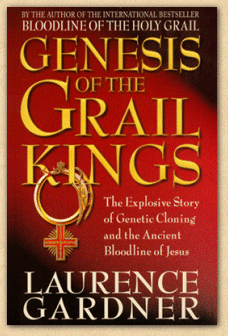 |
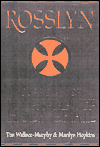 |
 |

|

|

|
 |
 |
 |
 |
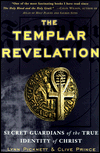 |
Search this site
Our search Engine does not search for the links in this site, only words in the text.
NO PART OF THIS SITE MAY BE COPIED OR REPRODUCED, IN WHOLE OR IN PART WITHOUT THE EXPRESS WRITTEN APPROVAL OF THE WEBMASTER... ę COPYRIGHT 1999 - 2009 C.I.C.ALL RIGHTS RESERVED
This page has been visited ... Times since March 23rd, 2001